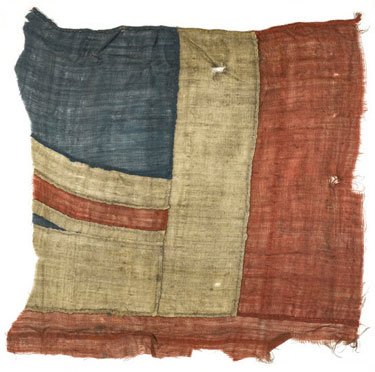At Sotheby’s London, “Of Royal and Noble Descent” Auction, Lot 116:
AN EXCEPTIONALLY LARGE FRAGMENT OF THE UNION FLAG, BELIEVED TO HAVE FLOWN FROM HMS VICTORY AT THE BATTLE OF TRAFALGAR
comprising eight panels of red, white and blue hand-woven woollen bunting, hand-stitched together to form part of the bottom-right (or top-left) quadrant of the Union flag, hemmed at the bottom (or top), hem turned over enclosing c.460mm of twine, crudely torn at the edges, c.860 x 920 mm, mounted, framed, and glazed (frame size 1125 x 1125mm), c.1801-1805AN EVOCATIVE AND IMPRESSIVE RELIC OF NELSON AND TRAFALGAR. Nelson’s ships sailed into battle at Trafalgar flying the national flag rather than just their squadron colours, as a result of an order issued by Nelson in the days before the battle: “When in the presence of an Enemy, all the Ships under my command are to bear white Colours [i.e. St George’s Ensign], and a Union Jack is to be suspended from the fore top-gallant stay” (10 October 1805). HMS Victory consequently flew two Union flags and a St George’s Ensign, which were returned to England with the ship and the body of Nelson.
These battle ensigns, unique patriotic mementoes of Nelson’s final and greatest victory, were later woven into the solemn and dignified series of ceremonials that marked his state funeral in January 1806. The body lay in state at the Painted Hall at Greenwich for four days before processing upriver in a funeral barge with a flotilla of naval escorts, disembarking at Whitehall Stairs and resting overnight in the Admiralty. The following day, 9 January, a vast procession followed Nelson’s remains to St Paul’s Cathedral, the site of the funeral. Incorporated into the funeral cortege was a group of 48 seamen and Marines from HMS Victory, who bore with them the ship’s three battle ensigns and were, according to one eyewitness, “repeatedly and almost continually cheered as they passed along”. At the conclusion of the funeral service, with the coffin placed at the heart of the cathedral beneath Wren’s great dome, the sailors were supposed to fold the flags and place them reverently on the coffin. The conclusion of the service, in fact, played out rather differently, as described by the Naval Chronicle (1806): “the Comptroller, Treasurer and Steward of his Lordship’s household then broke their staves, and gave the pieces to Garter, who threw then into the grave, in which all the flags of the Victory, furled up by the sailors were deposited – These brave fellows, however, desirous of retaining some memorials of their great and favourite commander, had torn off a considerable part of the largest flag, of which most of them obtained a portion.” According to one acute observer: “That was Nelson: the rest was so much the Herald’s office.” (See The Nelson Companion, ed. White (1995), pp8-14)
Most of the surviving fragments of the Victory’s flags are much smaller than the current piece. Small fragments of white and blue bunting, no more than 12cm in length, have appeared at auction (e.g. Bonhams, 28 September 2004, lot 117; Sotheby’s, 17 December 2009, lot 9) and other similar fragments are found at the National Maritime Museum and other institutional collections. Only two complete Union jacks that were used as battle ensigns at Trafalgar survive: one from HMS Minotaur (National Maritime Museum), the other from HMS Spartiate (sold at auction by Charles Miller Ltd., 21 October 2009, lot 53, £384,000).
Estimate: 80,000 — 100,000 GBP — 105,376 – 131,720 USD






Please Leave a Comment!